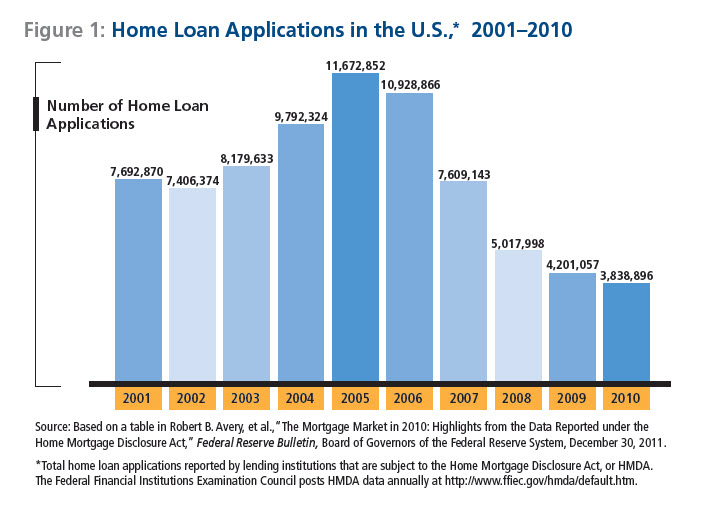Home prices in the U.S. have fallen precipitously from their pre-recession highs and interest rates are unprecedentedly low, yet the housing market remains sluggish. This sluggishness is reflected in the deflated number of loan applications submitted for single-family home purchases in the U.S. in 2009 and 2010, a figure that continues a downward trend in attempted home buying since the 2005 peak in applications. Although the mid-decade high point of applications reflected an unsustainable level of mortgage activity, the number of applications made five years later was more than 50 percent lower than the decade-long average (see Figure 1).1/ Simply put, something ails the housing market. But what?
 click to view larger image
click to view larger image
Chris Galler, CEO of the Minnesota Association of Realtors, sifts through mountains of data as he studies the housing market, and he can list off a battery of reasons why the housing market remains lethargic. One factor he points to is limited access to credit, which many previously qualified consumers are experiencing. Since early 2007, the average FICO® Score,2/ or credit score, of loan recipients nationwide has soared by approximately 50 points (see Figure 2).
 click to view larger image
click to view larger image
“Many lenders seem to want borrowers with credit scores greater than 700,” he says.
The increase in average credit scores reflects, among other things, a tightening of underwriting standards—a reversal of the less-stringent parameters some lenders had in place during the mid-decade housing boom.3/ According to Galler, the stricter underwriting standards disqualify a segment of the population that may have qualified for a loan six years ago but now, having FICO Scores in the mid- to low-600s, finds itself with no or poor home-buying options.
Another factor Galler identifies as inhibiting home buying: fewer young people are entering the market.
“In general, people are waiting a little longer to get married, and they’re having children later,” he says. “This has implications for when people buy their first home.”
In fact, since 1999, the percentage of 25- to 34-year-olds nationwide who have a mortgage has declined, from 18.5 to 17.1, while the percentage of people 35 and older who have a mortgage has increased, from 25.7 to 31.3 (see Figure 3). While the cause of this divergence between age cohorts could be a function of lifestyle preferences or the result of unstable personal financial conditions (such as an increase in student loan debt), the implication is that with fewer young people seeking to purchase homes, demand for homes—typically starter homes—may remain soft.
 click to view larger image
click to view larger image
But not all is hopeless, particularly for those who have poor credit scores. As Anita Olson, single family housing specialist at the Minneapolis office of the U.S. Department of Housing and Urban Development, says, “People don’t need to wait seven years to get back into the homeownership market. They can start restoring their credit right now, and in a relatively short amount of time—say, three years—start the process of buying a home.”
1/Robert B. Avery, et al.,“The Mortgage Market in 2010: Highlights from the Data Reported under the Home Mortgage Disclosure Act,” Federal Reserve Bulletin, Board of Governors of the Federal Reserve System, December 30, 2011.
2/The FICO Score, a product of the Fair Isaac Corporation, is widely used by lenders as an indicator of an individual’s credit risk. Scores range from 300 to 850; the higher the score, the lower the perceived risk. For more information, visit www.myfico.com.
3/The reluctance of lenders to make GSE (government sponsored enterprise)-eligible loans to potential borrowers with credit scores below 700 is reflected in the opinions of senior loan officers at 58 domestic banks and 23 U.S. branches and agencies of foreign banks, as reported in the Board of Governors of the Federal Reserve System’s April 2012 Senior Loan Officer Opinion Survey on Bank Lending Practices, available at http://federalreserve.gov/boarddocs/snloansurvey/201205/default.htm.





